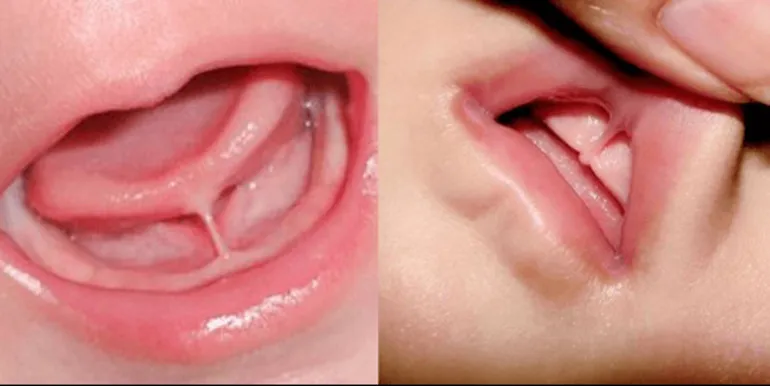Infant Tongue & Lip Tie / Frenectomy
Treating Babies with Love & Compassion:
Dr. Libby's Personal and Professional Journey
Dr. Libby, is a distinguished dentist and mom in southwest Michigan (Centreville, MI). She has dedicated her time and focus to infant lip and tongue tie treatment, as well as many other early intervention treatments. Dr. Libby brings a unique blend of professional expertise and personal experience to her practice. Her journey into this specialized field was deeply influenced by her own challenges breastfeeding her daughter, Tessa, who had a tongue tie. This personal connection fuels her commitment to helping families navigate similar difficulties, offering compassionate and informed care for infants with these conditions. Dr. Libby's approach is rooted in understanding, driven by her dual role as a dentist, and more importantly, a mother.
Understanding Infant Tongue Tie: Early Detection and Treatment
Tongue tie in infants, a condition where the strip of skin under a baby's tongue restricts tongue movement, can significantly impact feeding and jaw development. Early identification and intervention are crucial. This introduction explores the signs, implications, and treatment options for infant tongue tie, emphasizing the importance of timely care for optimal development and health.
Our laser frenectomy offers a swift, comfortable solution for children's tongue or lip tie issues, enhancing tooth alignment and tongue mobility without the need for anesthesia or a lengthy recovery.
Benefits include:
- Near painless experience
- Reduced infection risk
- Minimal bleeding
- Anesthesia-free, ideal for young patients
- Quick recovery
- Rapid procedure, completed in minutes
- Stitch-free treatment
Dr. Libby specializes in safe, effective frenectomies that correct tongue-tie and improve oral health.
Exploring Frenulum-Related Conditions: Tongue, Lip, and Cheek Ties
A frenulum is a tissue band connecting different parts of the body. Excessively tight frenula can cause problems in speaking, eating, and breastfeeding.
Tongue Tie: This occurs when the lingual frenulum, connecting the tongue to the mouth's floor, is too constricted.
Lip Tie: A tight labial frenulum, linking the lips to the mouth's gums, characterizes this condition.
Cheek Tie: Involves a restrictive buccal frenum, attaching the cheeks to the gums, potentially leading to functional difficulties.

Signs and Symptoms of Infant and Maternal Challenges with Ties
Infants with tongue, lip, or cheek ties may show signs like noisy suckling, difficulty maintaining suction, milk leakage, inadequate weight gain, coughing, lip blisters, gas pain, noisy breathing, and reflux symptoms.
Mothers might experience pain during breastfeeding, sore or cracked nipples, nipple shape changes post-feeding, extended feeding sessions, incomplete breast emptying, and reduced milk supply.
Symptoms in Mothers:
1. Nipple Pain: Includes severe pain during nursing, particularly at latch-on, signaling potential tie issues.
2. Incomplete Breast Emptying: Feeling of fullness post-feeding, indicating ineffective nursing due to ties.
3. Nipple Trauma: Symptoms like blisters or bleeding, often resulting from poor latch.
4. Pain Throughout Feedings: Persistent pain, suggesting latch difficulties due to ties.
5. Decreased Milk Supply: Lower milk production, potentially caused by inefficient feeding.
6. Frustration and Anxiety: Emotional stress linked to breastfeeding challenges.
7. Avoidance of Nursing: Reluctance due to discomfort, hinting at tie complications.
8. Thrush or Yeast Infections: Increased risk due to damaged nipples.
9. Latch Issues: Problems like biting sensation or clicking sounds during feeding.
10. Engorgement and Oversupply: Disproportionate milk production, related to ineffective feeding.
11. Feeling "Touched Out": Emotional discomfort leading to aversion to touch.
12. Stress and Fatigue: Increased tiredness and stress from nursing difficulties.
13. Use of Nipple Shields or Devices: Employing aids for pain reduction or improved latch.
Symptoms in Infants:
1. Difficulty Latching: Struggling to attach properly, a key indicator of ties.
2. Poor Weight Gain: Insufficient growth due to feeding issues.
3. Colic or Excessive Crying: Indicative of discomfort during feeding.
4. Gagging or Choking: Signs of feeding struggles.
5. Milk Leakage: Indicating ineffective sucking.
6. Short Feeding Times: Inability to feed adequately.
7. Frequent Feedings: Compensating for inefficient feeding.
8. Irritability during Feeding: Discomfort possibly due to tie.
9. Sleep Disruptions: Resulting from feeding difficulties and discomfort.
Post-Op Care Timeline for Infant Tongue Tie
Initial 0 - 5 Days
- Pain Management: Infants may experience discomfort which can be eased as per our care guide.
- Breastfeeding Adjustments: May face challenges in latching; consult with a lactation consultant if difficulties persist.
- Observing Healing Process: Normal healing may show a whitish film at the incision site; start prescribed stretching exercises.
Weeks 1 - 2
- Comfort Improvement: Discomfort should notably decrease as the infant gets used to the frenulum's new mobility.
- Feeding Techniques: Continue working with a lactation consultant to adapt breastfeeding techniques; bottle feeding may need adjustments.
Weeks 3 - 4
- Final Healing: Discomfort should be minimal; continue adapting feeding as needed.
- Complete Recovery: The incision site should be nearly healed, with the tissue looking more typical and increased frenulum motion.
